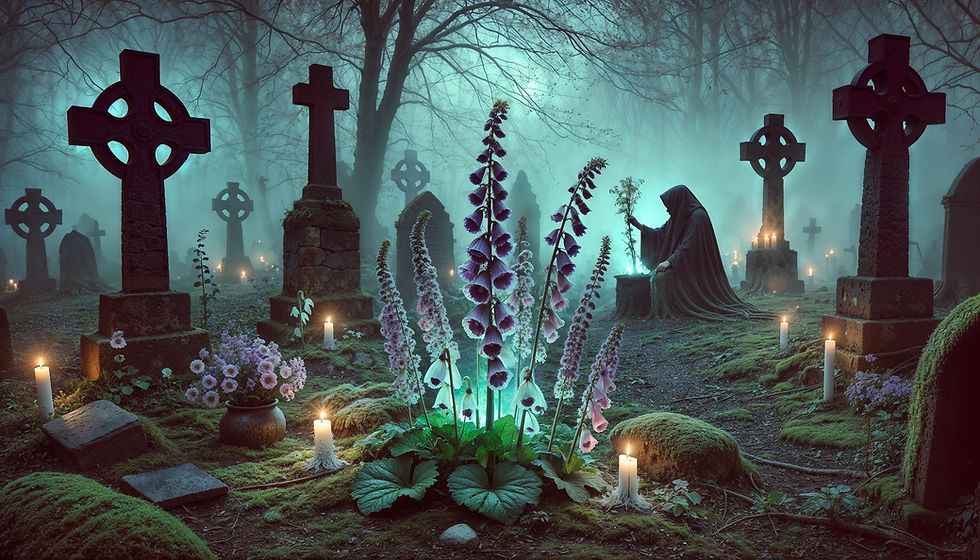The Plants That Grow Near Death
- RS

- Jul 18
- 3 min read
Not all herbs grow toward the sun. Some stretch their roots toward silence. Toward endings. Toward thresholds the living barely understand.
You will not find them in gardens of light. You will find them by old stones, under rusted gates, at the foot of the forgotten path. You will find them near death.
These are the Threshold Herbs—plants that thrive in liminal spaces. From the gravedust-kissed roots of Henbane, used in ancestral smoke rituals, to the pale blossoms of Aconite found near mountain burials, each carries stories etched in shadow. Folk texts speak of Mandragora twisting beneath gallows, and of Elder growing only where sorrow lingers deepest. These plants do not merely survive in death's wake—they awaken there.
Witch’s bane blooming only near crossroads. Bloodwort rising between gravestones. Black nightshade peeking through the cracks of abandoned homes.
They do not grow in defiance of death. They grow with it.

For centuries, rootworkers, witches, and folk healers have turned to these herbs not for healing of the body, but of the boundary. The veil. The edge.
Mugwort, known to whisper dreams into the ears of the half-asleep
Rue, whose bitterness chases spirits out and draws truth in
Graveyard moss, clinging to old stones and binding unspoken stories in its weave
They are not meant for casual tea. They are not sweet. They are teachers of endings and rebirth.
In Eastern Europe, old folk tales speak of Henbane and Wolfsbane sprouting near unmarked graves, believed to grow from the sorrow and memory buried beneath. In Slavic traditions, graveyard herbs were gathered on All Souls’ Eve, wrapped in black cloth, and kept in hidden pockets as talismans to communicate with ancestors.
The Polish 'ziola cmentarne'—cemetery herbs—were used in binding spells and protective rites, thought to absorb echoes from the veil itself. The Romani speak of a herb called Somnakay, which appears near deathbeds and disappears when the soul crosses fully.
In West African traditions, graveyard dirt is mixed with crushed plant roots for powerful ancestor rites. In the Appalachian mountains, folk conjurers gather herbs on Samhain, when the plants speak most clearly through death’s door.
But why do these herbs choose such haunting places? Why grow in soil soaked with sorrow?
Some say they feed on memory. Others say they root in places where the veil is thin.
But the old witches know the truth: These plants grow not despite death—but because of it. Because death is not an end. It is a door.
And some roots know how to knock.
If you find one, treat it with reverence. Don’t pluck it blindly. Sit beside it. Ask what it remembers. What it’s witnessed. What it guards.
And never harvest without offering something back. A breath. A song. A story. A moment of stillness.
Herbs that grow near death are not for flavor. These plants have been used in rites of passage and protection for centuries. Henbane was burned during ancestral summoning rituals to thin the veil.
Rue was bound into charms and placed above doors to keep death from lingering too long. Elder blossoms were soaked in moon water for rites of spiritual severance. Even mugwort, when placed beneath pillows, was said to bring dreams of the departed—and messages to the living. These practices endure not as superstition, but as maps for those who walk between worlds. They are for threshold work.
They guard between worlds. They know the scent of passing souls. They bloom in silence—and speak to those who listen with more than ears.
If you are called to them, it is because you are ready. Not to tame death. But to learn from it.
And in that knowing, something ancient will root in you, too. A memory not yours. A grief not spoken. A wisdom that blooms where endings once lived.
You’ll carry it with you. Like a dried herb in your pocket. Soft. Fragrant. Dangerous.
And you’ll know: Some plants do not fear death. They remember it. And through them—you will, too.

Explore Further
→ Herbs
→ Potions
Daily Rituals from the Roots of the Ancients:
Two herbal lineages in one powerful daily ritual: one forged from sea moss, black seed, and deep immunity; the other built on shilajit, ashwagandha, and mountain endurance. Choose the path your spirit leans toward—sea or stone.


Comments